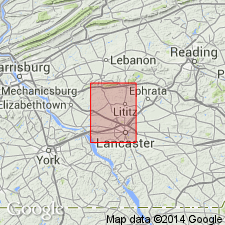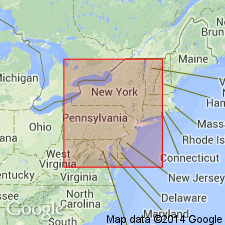
- Usage in publication:
-
- Elizabeth Furnace conglomerate member*
- Modifications:
-
- Named
- Dominant lithology:
-
- Conglomerate
- Sandstone
- AAPG geologic province:
-
- Gettysburg basin
- Piedmont-Blue Ridge province
Summary:
A lenticular mass of heavy conglomerate and hard sandstone in the Lancaster 15-min. quad. is named the Elizabeth Furnace conglomerate member of the Gettysburg shale. It begins west of Mount Hope, forms the ridge of Elizabeth Furnace Hill, which is cut through by the gorge of Hammer Creek, and passes northeastward out of the quad. Maximum thickness is 2,500 ft. Age is Late Triassic.
Source: GNU records (USGS DDS-6; Reston GNULEX).

- Usage in publication:
-
- Elizabeth Furnace Conglomerate Member†
- Modifications:
-
- Abandoned
- AAPG geologic province:
-
- Piedmont-Blue Ridge province
- Gettysburg basin
Summary:
The Hammer Creek Formation, defined between the Dauphin-Lebanon County line on the west and the Schuylkill River on the east, includes rocks previously defined as the Robeson Conglomerate and the Furnace Creek and Elizabeth Furnace Conglomerate Members of the Gettysburg Formation. The Elizabeth Furnace Member is not recognized in the Hammer Creek Formation.
Source: GNU records (USGS DDS-6; Reston GNULEX).
For more information, please contact Nancy Stamm, Geologic Names Committee Secretary.
Asterisk (*) indicates published by U.S. Geological Survey authors.
"No current usage" (†) implies that a name has been abandoned or has fallen into disuse. Former usage and, if known, replacement name given in parentheses ( ).
Slash (/) indicates name conflicts with nomenclatural guidelines (CSN, 1933; ACSN, 1961, 1970; NACSN, 1983, 2005, 2021). May be explained within brackets ([ ]).

